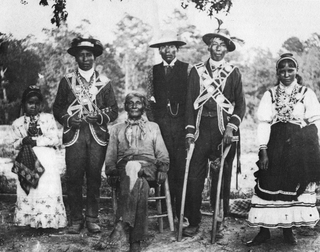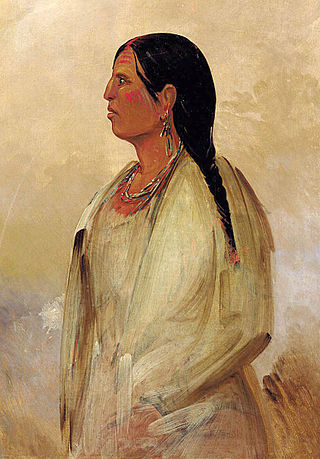
The Choctaw are a Native American people originally based in the Southeastern Woodlands, in what is now Alabama and Mississippi. Their Choctaw language is a Western Muskogean language. Today, Choctaw people are enrolled in three federally recognized tribes: the Choctaw Nation of Oklahoma, Mississippi Band of Choctaw Indians, and Jena Band of Choctaw Indians in Louisiana.
Mobilian Jargon was a pidgin used as a lingua franca among Native American groups living along the Gulf of Mexico around the time of European settlement of the region. It was the main language among Native tribes in this area, mainly Louisiana. There is evidence indicating its existence as early as the late 17th to early 18th century. The Native groups that are said to have used it were the Alabama, Apalachee, Biloxi, Chacato, Pakana, Pascagoula, Taensa, Tunica, Caddo, Chickasaw, Houma, Choctaw, Chitimacha, Natchez, and Ofo. The name is thought to refer to the Mobile Indians of the central Gulf Coast, but did not originate from this group; Mobilian Jargon is linguistically and grammatically different from the language traditionally spoken by the Mobile Indians.

Choctaw mythology is part of the culture of the Choctaw, a Native American tribe originally occupying a large territory in the present-day Southeastern United States: much of the states of Mississippi, Alabama, and Louisiana. In the 19th century, the Choctaw were known to European Americans as one of the "Five Civilized Tribes" even though controversy surrounds their removal.

Pascagoula is a city in Jackson County, Mississippi, United States. It is the principal city of the Pascagoula metropolitan area, and is part of the Gulfport–Biloxi–Pascagoula Combined Statistical Area and the Gulfport-Biloxi metropolitan area. The population was 22,392 at the 2010 census, down from 26,200 at the 2000 census. In 2019 the population was 21,699. It is the county seat of Jackson County.

The Tunica-Biloxi Indian Tribe, formerly known as the Tunica-Biloxi Indian Tribe of Louisiana, is a federally recognized tribe of primarily Tunica and Biloxi people, located in east central Louisiana. Descendants of Ofo (Siouan-speakers), Avoyel, and Choctaw are also enrolled in the tribe.

The Natchez are a Native American people who originally lived in the Natchez Bluffs area in the Lower Mississippi Valley, near the present-day city of Natchez, Mississippi, in the United States. They spoke a language with no known close relatives, although it may be very distantly related to the Muskogean languages of the Creek Confederacy. An early American geographer noted in his 1797 gazetteer that they were also known as the "Sun Set Indians".

The Atakapa or Atacapa were an Indigenous people of the Southeastern Woodlands, who spoke the Atakapa language and historically lived along the Gulf of Mexico in what is now Texas and Louisiana.

The Houma are a historic Native American people of Louisiana on the east side of the Red River of the South. Their descendants, the Houma people or the United Houma Nation, have been recognized by the state as a tribe since 1972, but are not recognized by the federal government.

Indigenous peoples of the Southeastern Woodlands, Southeastern cultures, or Southeast Indians are an ethnographic classification for Native Americans who have traditionally inhabited the area now part of the Southeastern United States and the northeastern border of Mexico, that share common cultural traits. This classification is a part of the Eastern Woodlands. The concept of a southeastern cultural region was developed by anthropologists, beginning with Otis Mason and Franz Boas in 1887. The boundaries of the region are defined more by shared cultural traits than by geographic distinctions. Because the cultures gradually instead of abruptly shift into Plains, Prairie, or Northeastern Woodlands cultures, scholars do not always agree on the exact limits of the Southeastern Woodland culture region. Shawnee, Powhatan, Waco, Tawakoni, Tonkawa, Karankawa, Quapaw, and Mosopelea are usually seen as marginally southeastern and their traditional lands represent the borders of the cultural region.

The Akokisa were an Indigenous tribe who lived on Galveston Bay and the lower Trinity and Sabine rivers in Texas, primarily in the present-day Greater Houston area. They were a band of the Atakapa Indians, closely related to the Atakapa of Lake Charles, Louisiana.
The Avoyel or Avoyelles were a small Native American tribe who at the time of European contact inhabited land near the mouth of the Red River at its confluence with the Atchafalaya River near present-day Marksville, Louisiana. The Avoyel are a member of the federally recognized Native American tribe and sovereign nation of the Tunica Biloxi Tribe of Louisiana.
Biloxi, Mississippi is a city in southeastern Mississippi, United States.

The Pascagoula River is a river, about 80 miles (130 km) long, in southeastern Mississippi in the United States. The river drains an area of about 8,800 square miles (23,000 km²) and flows into Mississippi Sound of the Gulf of Mexico. The Pascagoula River Basin is managed by the Pat Harrison Waterway District.
The Quinipissa were an Indigenous people of the Southeastern Woodlands who were living on the lower Mississippi River, in present-day Louisiana, as reported by René-Robert Cavelier, Sieur de La Salle in 1682.

Isle de Jean Charles is a narrow ridge of land situated in Terrebonne Parish, Louisiana. For over 170 years, it has been the historical homeland and burial ground of the state-recognized tribe of the Isle de Jean Charles Band of Biloxi-Chitimacha-Choctaw Indians. Residents of the Island have long been threatened by Louisiana's coastal erosion, as coastal Louisiana loses a landmass the size of Manhattan every year. In 1955, Isle de Jean Charles consisted of over 22,000 acres (8,900 ha) and has since lost about 98% of its land due to saltwater intrusion, and subsidence. In January 2016, the state of Louisiana received substantial funding from the United States Department of Housing and Urban Development to fund a community resettlement that was designed.
The Acolapissa were a small tribe of Native Americans of North America, who lived in the Southeast of what is the present-day United States. They lived along the banks of the Pearl River, between present-day Louisiana and Mississippi. They are believed to have spoken a Muskogean language, closely related to the Choctaw and Chickasaw spoken by other Southeast tribes of the Muskogean family.

The Opelousa were an Indigenous people of the Southeastern Woodlands in Louisiana. They lived near present-day Opelousas, Louisiana, west of the lower Mississippi River, in the 18th century. At various times, they allied with the neighboring Atakapa and Chitimacha peoples.

The Tunica people are a group of linguistically and culturally related Native American tribes in the Mississippi River Valley, which include the Tunica ; the Yazoo; the Koroa ; and possibly the Tioux. They first encountered Europeans in 1541 – members of the Hernando de Soto expedition.
The Pensacola were a Native American people who lived in the western part of what is now the Florida Panhandle and southwestern Alabama for centuries before first contact with Europeans until early in the 18th century. They spoke a Muskogean language. They are the source of the name of Pensacola Bay and the city of Pensacola. They lived in the area until the mid-18th century, but were thereafter assimilated into other groups.
The Capinan were a small tribe of Native American people from Alabama and Mississippi.













